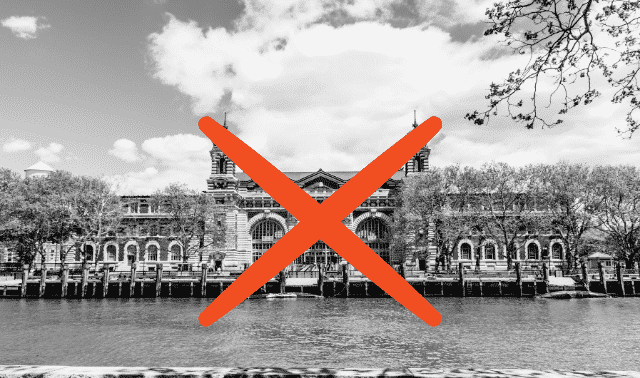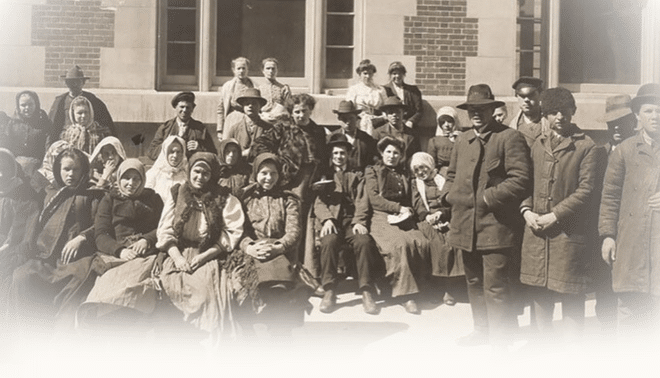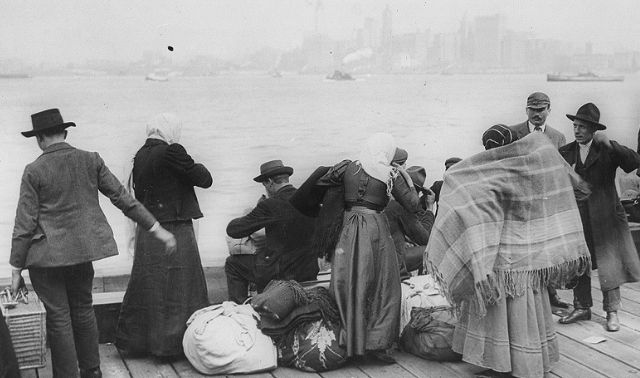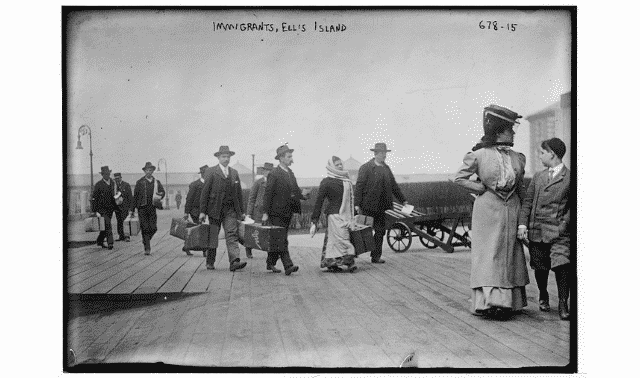
It’s one of America’s great romantic notions: masses of tired, hungry immigrants gazing upon the Statue of Liberty as their ships sail into New York Harbor, then stepping through Ellis Island’s “golden door” onto US soil. That might be how the journey ended for the more than 16 million immigrants whose boats docked in New York between 1892 and 1954 — but what if your ancestor was one of the millions more who entered through America’s 90-plus other ports? How do you find your family when you don’t have a massive online database like Ellis Island’s? Although it may take a little more digging, you have plenty of resources to help you. Here’s where to look.
Other Major Ports of Call
Five major US ports welcomed passenger ships during the 19th and early 20th centuries: Baltimore, Boston, New Orleans, New York and Philadelphia. New York was seeing three-quarters of all arrivals by the 1880s, when the nation’s largest flood of immigration began. That’s why Ellis Island (and its precursor, Castle Garden, open from 1855 to 1890) gets so much attention. But ships unloaded at more than 90 other ports on the Atlantic, Pacific and Gulf coasts, as well as the Great Lakes — including Detroit; Galveston, Texas; Gloucester and New Bedford, Mass.; Gulfport and Pascagoula, Miss.; Key West, Fla.; Portland, Maine; Providence, RI; San Francisco; Savannah, Ga.; and Seattle.
You might have heard that certain ethnic groups favored certain ports — for example, Boston was a popular destination for Irish immigrants. But keep in mind that each port has ushered in immigrants of just about every nationality and ethnic background. For example, the greatest influx of Italians came through the port of New York, but significant numbers also disembarked in New Orleans, Philadelphia, Baltimore and Boston.
Boston
Boston is the oldest continuously active US port of arrival. Long before Massachusetts Bay Colony formed in 1630, American Indian tribes settled and traded there. After Europeans arrived, Boston became a busy place for passengers, cargo vessels, trading ships and the shipbuilding industry. It was the gateway for expanding the East Coast Colonies. By the 1750s, the Mid-Atlantic Colonies were growing by leaps and bounds, and Philadelphia replaced Boston as the major center of arrival and trade. Not long after William Penn’s ship The Welcome landed on the shores of the Delaware River, Philadelphia became a leading center for trade and newcomers to the infant United States.
Baltimore
Founded in 1729, Baltimore received thousands of immigrants. It originally was established as a port to move crops along the Eastern Seaboard, as well as cargo to and from international destinations. Newcomers flocked to Baltimore partly because of its inland setting on the Chesapeake Bay — it was the closest Atlantic port to major Midwestern cities and manufacturing centers.
New Orleans
New Orleans became an epicenter of immigration and trading in the early 1700s, when the French owned Louisiana. People and cargo arrived at this port, then traveled north along the Mississippi River to their final destinations You might have heard that certain ethnic groups favored certain ports—for example, Boston was a popular destination for Irish immigrants. But keep in mind that each port has ushered in immigrants of just about every nationality and ethnic background. For example, the greatest influx of Italians came through the port of New York, but significant numbers also disembarked in New Orleans, Philadelphia, Baltimore and Boston.
Immigrants didn’t simply follow their countrymen’s leads; their destination ports often depended on such factors as what tickets cost, when the next ship was leaving, where their relatives had already settled, and where they’d heard jobs were available. So don’t limit your search to ports you’ve heard Germans or Swedes or Hungarians used. Instead, examine your research to see which destinations make the most sense for your family’s situation. And search for clues that suggest exactly where your ancestor arrived.
How to Discover Your Ancestors’ Port
Discovering your ancestors’ port — as well as the date they arrived — is the key to taking the next step in your search. You won’t be able to locate your family in passenger lists or indexes without those essential details. These sources can help you hunt them down:
Family members
Ask for letters, diaries, photographs and other mementos that would provide hints to the correct port. Something that may seem unimportant to a relative — or that she forgot she had — could help you immensely. Be sure to ask about the immigrant’s name in the old country, so you can search for that in indexes.
Censuses
Check every federal census taken during your ancestors’ lifetimes. The census first included immigration information in 1870, when it asked people to indicate whether they had foreign-born parents. Later censuses show immigrants’ years of arrival and naturalization (if they sought citizenship), parents’ birthplaces and (except for 1880) the immigrant’s ability to speak English.
State censuses may give even more detailed immigration information than federal enumerations. For example, New York state’s early 20th-century censuses asked for the year of immigration and whether the individual was naturalized, plus the court and city where the naturalization took place. See Ann Lain-hart’s State Census Records (Genealogical Publishing Co.) for a state-by-state list of these schedules, including what facts they contain and how to access them.
City directories
Tracing immigrants backward in city directories (volumes that list residents alphabetically, similar to today’s telephone books) sometimes helps you pinpoint an approximate year of arrival. Remember that immigrants might not show up in city directories until several years after their arrival, or they may appear sporadically because they relocated frequently. See the August 2003 Family Tree Magazine for a guide to using city directories.
Obituaries and death certificates
You often can find immigrant ancestors’ birthplaces and arrival dates in their obituaries. Likewise, some states’ death certificates reported how long the deceased person lived in America. Because the immigrants didn’t supply obituary details themselves, use the information as a starting point for your own research in original records.
Naturalization records
Depending on when your ancestor immigrated, naturalization records might give the precise date and port of arrival, as well as the ship’s name, the port of departure and the immigrant’s birth date and place. In some cases, though, you’ll only find the year the immigrant arrived.
You can get microfilmed indexes of some naturalization records, as well as the documents themselves, through FamilySearch.org. To access FamilySearch’s online catalog, click the Search tab and then type in the state of interest in the place search, then look for the subject heading Naturalization and Citizenship.
Next check courthouses — municipal, county, state and federal — where your immigrant ancestor arrived and/or settled, as well as city, county and state archives. Records of naturalizations that were made in municipal courts might be in the town halls or archives of major cities, such as in Baltimore, Chicago and St. Louis. If these avenues fail, and you’re seeking records dated after the federal government began providing naturalization services in 1906, write to US Citizenship and Immigration Services (formerly the Immigration and Naturalization Service).
Military draft records
Your immigrant ancestors had to register for the draft regardless of their citizenship status — and the records can tell you where they came from. For 19th- and early 20th-century immigrants, check Civil War and World War I draft records. During the Civil War, the Union drafted only aliens who’d declared their intent to naturalize. The records show those foreign-born draftees’ country of birth. These documents are available through Ancestry.com and you view them on site at the National Archives and Records Administration (NARA) in Washington, DC. World War I draft registrations provide immigrants’ birthplace and citizenship status.
Immigration indexes and finding aids
These tools — exhaustive compilations of facts and sources about immigrants — can provide a shortcut to finding your family’s port and date of arrival, or an original record that contains those details. For example, P. William Filby’s Passenger and Immigration Lists Index series, a multivolume guide to published immigration sources (not the actual passenger lists), now covers 4 million people. It’s especially useful for pre-1820 arrivals.
Also look for sources focusing on specific ethnic groups, such as Ira A. Glazier and P. William Filby’s The Famine Immigrants: Lists of Irish Immigrants Arriving at the Port of New York, 1846-1851 (six volumes); Germans to America: Lists of Passengers Arriving at U.S. Ports, 1850-1891 (60 volumes); and Italians to America: Lists of Passengers Arriving at U.S. Ports, 1880-1899 (16 volumes).
The Morton Allan Directory of European Passenger Steamship Arrivals for the Years 1890 to 1930 at the Port of New York and for the Years 1904 to 1926 at the Ports of New York, Philadelphia, Boston, and Baltimore (Genealogical Publishing Co.) can be particularly helpful if you’ve learned the ship’s name from family stories or other sources, but you still can’t find the port or arrival date. Sometimes ship names get convoluted when relatives pass on family stories, or the presumed arrival dates aren’t correct. The Morton Allan Directory will give you the correct ship name and arrival date. But keep in mind that it gives dates ships were scheduled to arrive, not the actual arrival dates — delays of a few days were common.
Web sites
In addition to Ancestry.com’s subscription collections, free online tools can help you learn when and where your family landed on America’s shores. Get started with Cyndi’s List; check under the Ports of Entry and the Ships and Passenger Lists categories. If that doesn’t give you enough to look at, browse the links under Immigration and Naturalization and Ports of Departure.
Stop next at the Immigrant Ships Transcribers Guild. This group of volunteers makes passenger list transcriptions — more than 30,000 so far, covering a half-million passengers — available for free. Olive Tree Genealogy links to many off-site passenger-list sources; its own free resources cover mainly pre-1820 immigration.
Passenger Lists
The information you glean from those intial sources will help you hunt down your ancestors’ passenger lists — the documents that recorded their journeys from the Old World to the New. The US government began using passenger lists in 1820 to keep track of people arriving from overseas and to protect travelers from overcrowded ships. The forms were printed in the United States, and shipping-company personnel filled them out at the port of departure. If your ancestors immigrated during the 19th or early 20th century, you’ll find them on one of these two types of passenger lists:
Customs lists (1820 to about 1891): The government used these lists primarily for statistical purposes, so they don’t hold extensive details — generally just the name of the ship and its master; the port of embarkation; the date and port of arrival; and each passenger’s name, sex, age, occupation and nationality.
Immigration passenger lists (1891 to 1954): The information provided in these lists varied over the decades and grew along with the influx of immigrants. In 1893, passenger lists had 21 columns of information; by 1917, the government had added 12 more. Passenger lists contain genealogical gems you might not find elsewhere, such as the immigrant’s last residence, birthplace, physical description and final destination in the United States; a US relative’s name and address; and the name and address of the immigrant’s closest living relative in the native country.
NARA has microfilmed most original passenger lists from 1820 to 1957 (with some gaps). To tap those records, start by consulting an index. (If you still don’t know the port, you could use a process-of-elimination strategy by first checking indexes for major ports and those near your ancestors’ US hometown.) Below, you’ll find a handy list of dates for 23 popular entry points’ records. If you can’t find your ancestors at the first city you check, try others nearby. (Keep in mind that each port may not have complete coverage within the span of years listed.)
- Baltimore 1820-1897, 1891-1957
- Beaufort, NC 1865
- Boston 1820-1874, 1883-1891, 1891-1943
- Bridgeport, Conn. 1870, 1929-1959
- Charleston, SC 1820-1829, 1865, 1890-1939
- Galveston, Texas 1846-1951
- Gloucester, Mass. 1820, 1832-1839, 1867-1868, 1870, 1906-1943
- Gulfport and Pascagoula, Miss. 1903-1954
- Key West, Fla. 1837-1852, 1857-1868, 1890-1945
- New Bedford, Mass. 1822, 1825-1852, 1902-1954
- New London, Conn. 1820-1847, 1929-1959
- New Orleans 1813-1952
- Newport, RI 1820-1852, 1857
- New York City 1789-1957
- Norfolk and Portsmouth, Va. 1820-1857
- Pensacola, Fla. 1890-1948
- Philadelphia 1800-1882, 1883-1948
- Portland, Maine 1893-1943
- Providence, RI 1820-1867, 1911-1954
- San Francisco 1882-1957
- Savannah, Ga. 1820-1826, 1831, 1847-1851, 1865-1868, 1890-1945
- Seattle 1882-1957
- Wilmington, Del. 1820, 1830-1831, 1833, 1840-1849
Tip: You may find ancestors who immigrated before 1820 on “baggage lists.” Shipmasters recorded the names of passengers carrying baggage so those travelers wouldn’t have to pay duties on their belongings once they reached their intended port.
From the September 2005 Family Tree Sourcebook
You’ve probably noticed some gaps in availability of indexes to the four ports we’ve mentioned. That’s because not all lists survived, and not all ports have been indexed or have all-inclusive indexes. Boston is a good example: According to John Philip Colletta’s They Came in Ships (Ancestry), fire destroyed Boston’s pre-1883 original customs lists, so State Department copies and transcriptions were used to create the indexes — but those substitutes don’t cover April 1, 1874 to Dec. 31, 1882. “Fortunately,” writes Colletta, “passenger arrival records created in accordance with a Massachusetts state law of 1848 serve to fill in that gap.” See Colletta’s book for the peculiarities of other ports of arrival.
The indexes consist of cards that outline some of the passenger details recorded on the original passenger lists — usually name, age, sex and a reference to the ship’s list. You’ll want to copy your relative’s information, then move on to the microfilm of the full lists (look for roll numbers in NARA’s Immigrant and Passenger arrivals catalog). Besides having the opportunity to check for transcription errors and missed details, you’ll get the thrill of seeing a replica of the record bearing your ancestor’s name.
Once you’re looking at the manifest, you’ll need to scan down the list for your ancestor’s name if you don’t have information from an index or database that takes you to the entry. Passengers won’t appear in alphabetical order on each ship’s list, since they didn’t buy their tickets in alphabetical order. But they will be grouped together with their family or fellow traveling companions.
Look first for your ancestor’s original name — the one he or she used in the old country. That’s the name that most likely was recorded on the passenger manifest (remember, the lists were compiled at the port of departure). Immigrants usually didn’t change their names until they began assimilating into American society. (See the December 2003 Family Tree Magazine to learn more about foreign names.)
If a passenger died during the voyage, that may be noted near the person’s name, or you might find an additional entry at the end of the manifest. A line through the name indicates that the passenger bought a ticket, but didn’t board. Babies born at sea and stowaways discovered during the trip typically got added to the last page of the ship’s list.
So how do you access these lists and indexes? You don’t have to trek to NARA’s headquarters in Washington, DC. Each of NARA’s regional facilities has microfilmed records for the ports in its jurisdiction — contact the centers for availability. FamilySearch.org also has digitized copies. So you can search its catalog. Some ports’ passenger records are indexed online, in free databases and Ancestry.com’s and Genealogy.com’s subscription collections. Searching a Web-based index can be faster than reading through digitized microfilms, but keep in mind that all indexes have their share of errors and omissions. If the transcriber couldn’t read the handwriting on the ship’s list, she might have copied the name incorrectly.
A giant database like Ellis Island’s is nice, but we can’t all have it so easy. Now that you know where to start, you’ll find out which port was your ancestor’s golden door.
Angel Island Ancestors
Opened in 1910 in the area of San Francisco Bay known as China Cove, Angel Island <www.angelisland.org/immigr02.html> became the top immigrant receiving station on the West Coast — hence its nickname, “Ellis Island of the West.” Its function was to control the flow of Chinese — who were officially “unwelcomed” by the Chinese Exclusion Act of 1882 — into the country.
The National Archives has a variety of microfilmed records for the Port of San Francisco, including:
• Indexes to Passenger Lists of Vessels Arriving at San Francisco, 1893-1934
• Passenger Lists of Vessels Arriving at San Francisco, 1893-1953
• Registers of Chinese Laborers Arriving at San Francisco, 1882-1888
• Lists of Chinese Passengers Arriving at San Francisco, 1888-1914
• Lists of Chinese Applying for Admission to the United States through the Port of San Francisco, 1903-1947
Many immigrant families arrived through Canadian ports, and some settled for a time in Canada before moving to the United States. The US government didn’t keep records on these “border crossers” until 1895, when it realized that about 40 percent of immigrants to Canada planned to end up in the United States. Then joint US-Canadian immigrant inspection created two sets of records: passenger lists and inspection cards.
The US Immigration and Naturalization Service’s Montreal district centralized records from all ports in its jurisdiction at its headquarters, which originally was in Montreal and later moved to St. Albans, Vt. (that’s why you’ll hear these records called the “St. Albans lists”). This district includes US border entries at Washington, Montana, Michigan, New York, North Dakota and Minnesota. You’ll find these records on microfilm at the National Archives, its regional facilities and through the FHL (except where noted):
• Soundex Index to Canadian Border Entries Through the St. Albans, Vermont, District, 1895-1924
• Soundex Index to Entries into the St. Albans, Vermont, District Through Canadian Pacific and Atlantic Ports, 1924-1952
• Alphabetical Index to Canadian Border Entries Through Small Ports in Vermont, 1895-1924
• Manifests of Passengers Arriving in the St. Albans, Vermont, District Through Canadian Pacific and Atlantic Ports, 1895-1921
• Manifests of Passengers Arriving in the St. Albans, Vermont, District Through Canadian Pacific and Atlantic Ports, 1921-1954 (not at the FHL)
• Manifests of Passengers Arriving in the St. Albans, Vermont, District Through Canadian Pacific Ports, 1929-1949
Like US passenger lists, Canadian border-crossing records have been indexed using Soundex, a system that groups similar-sounding names together (see <www.familytreemagazine.com/articles/juneOO/soundex.html> for more on Soundex). The Soundex cards for Canadian border crossings are on microfilm and arranged by the Soundex code, then alphabetically by the passenger’s first name. Each card contains an abstract of the information found on the manifest.
Grosse Île, an island in the St. Lawrence River just downstream from Quebec City, is to Canada what Ellis Island is to the United States. Between 1829 and 1941, 4.3 million people arrived there by boat, the majority after 1867. Most came from the British Isles, Scandinavia and Germany. From 1832 to 1937, ships would pause at Grosse Île for health inspection; some 31,829 people were hospitalized, and more than 7,400 were buried there, including those who died at sea. The island became a national historic site in 1974.
Begin your Grosse Îie research with a virtual visit to Parks Canada’s Grosse Île and The Irish Memorial <parkscanada.pch.gc.ca/lhn-nhs/qc/grosseile/index_e.asp>. The Web site provides general information on the park (including a virtual tour) and the 1847 typhoid epidemic. About 100,000 immigrants, mostly Irish escaping the potato famine, passed through Grosse île in 1847 — the year typhoid overwhelmed the station. Nearly 5,424 died and were buried on the island, the worst year in Grosse Île’s history.
Next, search the National Archives of Canada Web site Immigrants at Crosse-île <www.genealogy.gc.ca/01/010202_e.html>, which hosts a database of 33,026 people who stayed at the quarantine station between 1832 and 1937. You can search by name, ship, year and place of origin.
Doukhobors Quarantined at Grosse Isle <www.doukhobor.org/Gross-lsle.htm> tells of another illness-related tragedy on the island. In 1899, a ship carrying 2,275 Doukhobors — Russian peasants who emigrated to avoid persecution over differences with the Russian Orthodox Church — was infected with smallpox. The site lists the names and ages of 47 who were treated for smallpox and seven who died.
The site Immigrants to Canada <Error! Hyperlink reference not valid.> provides more general information and links relating to Grosse Île and Quebec. You’ll find lists of ships’ names, regulations and more.
InGeneas <www.ingeneas.com> has searchable Grosse îie hospital, death and burial records, plus records of European arrivals at the Port of Quebec for 1870 and April through September 1871. You can order electronic transcriptions for $7 to $10.
The National Archives of Canada has microfilmed original passenger lists from Canadian ports, including Quebec (see <www.archives.ca/02/02020204_e.html>). You can search an index to lists from 1865 to 1935 at <www.archives.ca/02/020118_e.html>. InGeneas offers a free index to earlier arrivals (1801 to 1849).
— Peter D.A. Warwick
Toolkit
Web Sites
• Angel Island Immigration Station
• Angel Island Immigration Station Foundation
• Cyndi’s List
<www.cyndislist.com>: Check the Ports of Entry, Ships and Passenger Lists, Immigration and Naturalization, and Ports of Departure categories.
• Great Ships
• Immigrant Arrivals: A Guide to Published Sources
<www.loc.gov/rr/genealogy/bib_guid/immigrant>
• Immigrant Ships Transcribers Guild
• Immigration … The Changing Face of America
<lcweb2.loc.gov/ammem/ndlpedu/features/immig>
• National Archives of Canada Immigration Records
<www.archives.ca/02/02020204_e.html>
• Olive Tree Genealogy
<olivetreegenealogy.com/ships>
• Peopling North America: Population Movements and Migration
<www.ucalgary.ca/applied_history/tutor/migrations/Fhome.html>
• Resources for Finding Passenger Arrival Records at the Port of New Orleans, Louisiana
<home.att.net/~wee-monster/neworleans.html>
• TheShipsList
• US Ports of Arrival and Their Available Passenger Lists, 1820-1957
<www.genesearch.com/ports.html>
Books
• American Passenger Arrival Records by Michael Tepper (Genealogical Publishing Co.)
• A Genealogist’s Guide to Discovering Your Immigrant & Ethnic Ancestors by Sharon DeBartolo Carmack (Betterway Books, out of print)
• Guide to Genealogical Research in the National Archives of the United States, 3rd edition, edited by Anne Bruner Eales and Robert M. Kvasnicka (National Archives Trust Fund Board)
• Guide to Naturalization Records of the United States by Christina K. Schaefer (Genealogical Publishing Co., out of print)
• Ships of Our Ancestors by Michael J. Anuta (Genealogical Publishing Co.)
• They Became Americans: Finding Naturalization Records and Ethnic Origins by Loretto Dennis Szucs (Ancestry)
• They Came in Ships by John Philip Colletta (Ancestry)
Organizations
• National Archives and Records Administration
700 Pennsylvania Ave. NW, Washington, DC 20408, (866) 325-7208, <www.archives.gov>
• Immigration History Research Center
University of Minnesota, 311 Andersen Library, 222 21st Ave. S., Minneapolis, MN 55455, (612) 625-4800, <www1.umn.edu/ihrc>
• US Citizenship and Immigration Services
From the August 2004 issue of Family Tree Magazine.




